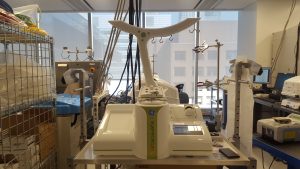
Cytiva’s Sefia S-2000 Cell Processing instrument in the Centre for Advanced Therapeutic Cell Technologies at CCRM, Toronto.
In 2019, CCRM launched a new blog to explain products, processes, terms, technologies, techniques and much more related to developing and manufacturing cell and gene therapy products. As a contract development and manufacturing organization (CDMO), CCRM wanted to share its knowledge with the global community.
Fast forward to 2023 and CCRM is retiring the CDMO blog. It will find a new home with OmniaBio Inc., its subsidiary. OmniaBio is a CDMO offering preclinical to commercial-stage manufacturing for cell and gene therapy customers. New content is coming soon. In the meantime, here’s one from the archives (written by CCRM scientists).
Concentration and reformulation of cellular immunotherapies – a major downstream processing step
Cellular immunotherapies (e.g. CAR-T cells) are primarily used as an autologous therapy to treat cancer. As such, these therapies are currently generated in small batches for each patient. To generate enough modified cells for a single treatment, cells are expanded in volumes from 1-10 L. In the final step of downstream processing (DSP) for immunotherapies, cells cultured in large volumes must be concentrated and reformulated into smaller volumes (e.g. 20-100 mL) suitable for delivery to patients.
In this post, we will outline the key steps for concentration and reformulation and highlight specialized equipment needed for this critical unit operation. CCRM’s team has leveraged a partnership with GE Healthcare (now Cytiva) to create an innovative process based on modular and closed unit operations that can be staggered to produce multiple doses of an autologous therapy simultaneously.
Steps for concentration and reformulation of immunotherapies:
- Transfer from bioreactor: Traditionally the transfer of cells grown in suspension from one vessel to another would be accomplished by moving vessels such as bottles, tubes and flasks into and out of a biosafety cabinet (BSC), whereby fluid volumes are manipulated with pipettes. This process is open, manual, and not scalable.
Instead, we have developed a full process using wave-mixed bioreactors where cells are expanded in single-use bags (up to 10 L) that can be aseptically welded directly onto equipment for isolation, harvesting and final formulation of cells (e.g. Sefia Cell Processing System S-2000, kSep, LOVO, Rotea).
- Volume reduction, washing and final formulation: Currently, immunotherapy workflows rely on bulk centrifugation including labour-intensive, open manipulations in a BSC. In our process, these steps are carried out by one piece of equipment that combines several steps, reduces labour costs, and has built-in automation capabilities.
This device uses single-use consumables, accommodates sterile welds for seamless unit-op to unit-op transfer, and can process 1 L of cell suspension down to 40 mL in less than an hour. This represents an important advancement over traditional methods using a centrifuge because system closure and automation can significantly reduce the risk of operator error and contamination while increasing process robustness.
Final product formulation most commonly involves the addition of a cryoprotectant to cells under a BSC (often in cryovials) as cryopreservation is a critical unit operation and is almost always required for immunotherapies that will be shipped to hospitals from centralized manufacturing facilities. Equipment such as the Sefia CPS S-2000 can add cryoprotectant to bags, control rate of cryoprotectant addition, temperature, and mixing to minimize potential damage to the cells.
Future process improvements for DSP of immunotherapies:
As immunotherapies evolve, so will the processes that therapy developers use to produce them. For instance, as we move towards the use of allogeneic therapies manufactured in large bioreactors, we will need to build DSP equipment that can accommodate much larger volumes.
While we have made significant strides in the development of closed and automated processes, there remain opportunities for further improvements. For example, a gap in the field is a method for rapid and high-throughput bag filling that would allow for the creation of master cell banks under completely closed conditions.
Another key gap is the lack of a closed and automated system for removing air from cell cryopreservation bags prior to freezing. Air bubbles interfere with uniform and optimal cooling of cells, and currently are being removed manually in a biosafety cabinet by many developers, which opens the final product to contamination risk. An automated solution to overcome this challenge would save time and greatly reduce variability and risk.
Ultimately, the process developed at CCRM, in partnership with GEHC, was informed by the needs of industry.
If this type of technical post is of interest to you, be sure to visit the CDMO blog on OmniaBio’s website for more insights into manufacturing for cell and gene therapies.
Stacey Johnson
Latest posts by Stacey Johnson (see all)
- Right Turn: Stem cell supplements: A growing market with growing risks - December 19, 2025
- Right Turn: Beyond the ’stache: The science, the progress, the promise - November 26, 2025
- Right Turn: Can Bryan Johnson live forever? Will regenerative medicine help him do so? - October 10, 2025






Comments